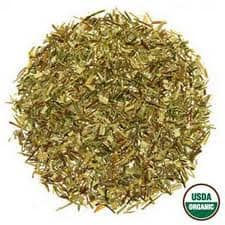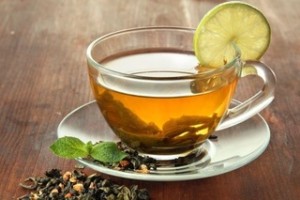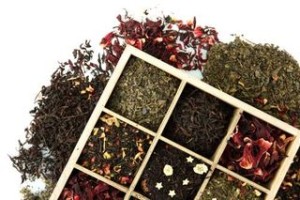Rooibos Tea (Green)
NEWS: This superfood is now available in the SANEStore as a convenient whole-food powder so you can more easily enjoy it in smoothies and recipes.

The herbal tea made from rooibos (pronounced Roy-Boss) has been a popular drink in Southern Africa for generations. The plant, Aspalathus linearis, is grown only in a small area in the Western Cape province of South Africa, but during recent years rooibos has become popular in other parts of the world as well.
There are two varieties of rooibos tea. One is referred to as red rooibos and the other is green rooibos. Typically, rooibos leaves are oxidized before they are used to make red rooibos tea. This process, gives them the familiar reddish-brown color and the slightly sweet taste. An alternative treatment of the leaves and twigs does not include the fermentation or oxidation step and produces what is referred to as green rooibos. The tea made from unfermented rooibos has a yellow tan color. The green rooibos tea possesses a milder taste.
Rooibos tea is a concentrated source of antioxidants and flavonoids. In fact, Rooibos tea has been found to have as much as 50 times more Superoxide Dismutase (SOD) than Green Tea. It also has other antioxidants not found in other teas like aspalathin and nothofagin. It is naturally mineral rich, caffeine free and has low tannin levels compared to black and green teas.
Drinking organic green rooibos tea has number of health benefits. Traditional medicinal uses of rooibos in South Africa include alleviating nervous tension, infantile colic, allergies, asthma and digestive problems. When applied externally rooibos can be helpful for a number of skin irritations like itchy skin, eczema, dermatitis, sunburns, diaper rash, acne and rosacea. The alpha hydroxy acid and zinc contained in Green Rooibos Tea promotes healthy, smooth skin.
Studies suggest rooibos has potent antioxidant, immune-modulating and chemopreventive effects. In addition, green rooibos tea has not been found to have any adverse effects. In another study normal healthy rats given rooibos tea instead of water had significantly higher serum superoxide dismutase (SOD) levels than the control rats. They also had less DNA damage and accumulate significantly less aging damage in the brain than rats given water. In fact, the 24-month old rats given rooibos tea for most of their lives had brains similar to young 5-week-old rats. Futhermore, when the rats were given dextran sodium sulfate to induce colitis, the rooibos group had higher SOD levels, and the drop in hemoglobin levels seen in the control group was prevented. Thus, rooibos tea seems to be anti-inflammatory and have the potential to prevent DNA damage.
Due to the effects of rooibos on vasodilation and vasoconstriction, angiotensin I-converting enzyme (ACE) inhibitors and nitric oxide (NO) it has been used to treat conditions such as high blood pressure and heart failure. In one study, the effect of green tea, black tea and rooibos tea on ACE and NO was compared in healthy human volunteers. None of the three had a marked effect on NO concentration, but both green tea and rooibos tea inhibited ACE activity, suggesting that they have cardiovascular benefits.
Rooibos tea may help with diabetes as well. In a study on mice with type 2 diabetes, aslapathin suppresses the increase in fasting blood glucose levels. It also improves glucose tolerance, apparently through stimulating glucose uptake in muscle tissues and insulin secretion from the pancreas. So drinking rooibos tea during a meal may not be a bad idea.
Rooibos tea also has therapeutic potential for respiratory ailments. According to a study on rats, in addition to lowering blood pressure, rooibos tea is both a bronchodilator and an antispasmodic. This helps explain why rooibos tea is commonly used for gastrointestinal and respiratory problems. The flavonoid chrysoeriol seems to be mainly responsible for the bronchodilator and antispasmodic effect.
Unoxidised green rooibos tea contains more than twice the flavonoids as the oxidized red rooibos tea and 10 times the aspalathin and nothofagin. In the studies that have directly compared the two, the unoxidised green rooibos seems to generally come out on top. For example, unoxidised green rooibos tea seems to protect rats from liver cancer more effectively than the oxidized green rooibos tea.
Why Try Rooibos Tea (Green) Superfood?
- Eases irritability, headaches, nervous tension & insomnia
- Aiding in liver tissue regeneration after prolonged intoxication
- Alleviating allergies, asthma & hay fever
- Containing no oxalic acid, making it a great choice for kidney stone sufferers
- Inhibiting lipid peroxidation
- Reducing digestive & gastrointestinal problems
- Containing a variety of vitamins and minerals, as well as other phytonutrients
- Suppressing fasting glucose levels
- Acts as an antispasmodic agent, to relieve stomach cramps & colic in infants
- Anti-aging properties
- Acting as an anti-inflammatory
- Containing polyphenols shown to have antimutagenic, & anti-viral properties
- Improving glucose tolerance
- Acting as a bronchodilator & antispasmodic
- Containing alpha hydroxyl acid & zinc content, & may be applied topically to ease acne, eczema, sunburn, etc.
- Protecting cell proteins, cell fats, & DNA
- Supporting healthy cholesterol & blood pressure levels
- Acting as as vasodilator improving circulation
- Normalizing blood pressure
- Inhibiting rotavirus infection
- Strengthening bones and teeth
- Boosting the immune system
- Low in tannins which allows easier assimilation of its minerals
- Promoting healthy smooth skin
- High levels of antioxidants: Superoxide Dismutase (SOD), aspalathin & nothofagin
- Improving glucose uptake & insulin secretion after a meals
- Cardiovascular protection through ACE inhibition
- Combating brain aging
- Reducing eczema, sunburns, diaper rash, dermatitis, acne & rosacea when used externally
References
1. Standley, L; Winterton, P; Marnewick, JL; Gelderblom, WC; Joubert, E; Britz, TJ (2001 Jan). Influence of processing stages on antimutagenic and antioxidant potentials of rooibos tea.. Journal of agricultural and food chemistry 49 (1): 114–7. PMID 11170567.
2. Theunissen, Izelle (March http://www.scienceinafrica.co.za/2005/march/rooibos.htm). “Rooibos the healthy tea”. Science in Africa.
3. Morton, Julia F. (1983). “Rooibos tea,aspalathus linearis, a caffeineless, low-tannin beverage”. Economic Botany 37 (2): 164–73. doi:10.1007/BF02858780. JSTOR 4254477.
4. Krafczyk, Nicole; Woyand, Franziska; Glomb, Marcus A. (2009). “Structure-antioxidant relationship of flavonoids from fermented rooibos”. Molecular Nutrition & Food Research 53 (5): 635–42. doi:10.1002/mnfr.200800117. PMID 19156714.
5. Bramati, Lorenzo; Minoggio, Markus; Gardana, Claudio; Simonetti, Paolo; Mauri, Pierluigi; Pietta, Piergiorgio (2002). “Quantitative Characterization of Flavonoid Compounds in Rooibos Tea (Aspalathus linearis) by LC−UV/DAD”. Journal of Agricultural and Food Chemistry 50 (20): 5513–9. doi:10.1021/jf025697h. PMID 12236672.
6. Dew, Tristan P.; Day, Andrea J.; Morgan, Michael R. A. (2005). “Xanthine Oxidase Activity in Vitro: Effects of Food Extracts and Components”. Journal of Agricultural and Food Chemistry 53 (16): 6510–5. doi:10.1021/jf050716j. PMID 16076142.
7. Rubin, T. (February 2010). Better Nutrition 72 (2): 48–9.
8. Almajano, M. Pilar; Carbó, Rosa; Jiménez, J. Angel López; Gordon, Michael H. (2008). “Antioxidant and antimicrobial activities of tea infusions”. Food Chemistry 108: 55. doi:10.1016/j.foodchem.2007.10.040.
9. Joubert, E.; Gelderblom, W.C.A.; Louw, A.; De Beer, D. (2008). “South African herbal teas: Aspalathus linearis, Cyclopia spp. And Athrixia phylicoides—A review”. Journal of Ethnopharmacology 119 (3): 376–412. doi:10.1016/j.jep.2008.06.014. PMID 18621121.
10. a b McKay, Diane L.; Blumberg, Jeffrey B. (2007). “A review of the bioactivity of south African herbal teas: Rooibos (Aspalathus linearis) and honeybush (Cyclopia intermedia)”. Phytotherapy Research 21 (1): 1–16. doi:10.1002/ptr.1992. PMID 16927447.
11. Sinisalo, Marjatta; Enkovaara, Anna-Liisa; Kivistö, Kari T. (2010). “Possible hepatotoxic effect of rooibos tea: A case report”. European Journal of Clinical Pharmacology 66 (4): 427–8. doi:10.1007/s00228-009-0776-7. PMID 20072844.
12. Gadow, A.Von; Joubert, E.; Hansmann, C.F. (1997). “Comparison of the antioxidant activity of rooibos tea (Aspalathus linearis) with green, oolong and black tea”. Food Chemistry 60: 73. doi:10.1016/S0308-8146(96)00312-3.
13. “Exotic frogs reared in redbush tea in Gloucestershire”. BBC News. 2010-06-07. Retrieved 2010-09-12.
14. Marnewick, Jeanine L.; Rautenbach, Fanie; Venter, Irma; Neethling, Henry; Blackhurst, Dee M.; Wolmarans, Petro; Macharia, Muiruri (2011). “Effects of rooibos (Aspalathus linearis) on oxidative stress and biochemical parameters in adults at risk for cardiovascular disease”. Journal of Ethnopharmacology 133 (1): 46–52. doi:10.1016/j.jep.2010.08.061. PMID 20833235.
15. “Rooibos History”. South African Rooibos Council. Retrieved 2008-08-19.[unreliable source?]
16. History of Rooibos – Dragonfly Teas.
17. a b Green, Lawrence (1949). In The Land of the Afternoon. Standard Press Ltd. pp. 52 to 54.
18. Klein Kliphuis Hotel website.
19. Rooibos Trademark Abandoned American Herbal Products Association (AHPA) press release, 2005-06-28. Retrieved 2012-04-07.
20.”Intellectual Property Laws Amendment Bill: Draft, (G 31026, GeN 552)”. South African Government Information. 2008-05-05. Retrieved 2008-10-11.
21. Trade Environment Database entry on “rooibos” name dispute in US.
22. http://www.vegetarian-nutrition.info/herbs/rooibos.php
23. http://www.mountainroseherbs.com/learn/rooibos.html
24. http://www.sarooibos.org.za
25. http://www.rooibostea.com/benefits-of-rooibos-tea.php
26. http://naturalhealthremedies.org
27. http://www.naturalnews.com/042265_rooibos_tea_phytonutrients_health_benefits.html
28. http://www.naturalnews.com/042231_rooibos_history_South_Africa.html
29. http://www.naturalnews.com/035923_coffee_rooibos_energy.html
30. http://inhumanexperiment.blogspot.com/2010/04/many-health-benefits-of-rooibos-tea.html
31. http://www.organicfacts.net/health-benefits/beverage/health-benefits-of-red-rooibos-tea.html
32. http://en.wikipedia.org/wiki/Rooibos
33. http://www.rooibostea.com/history-of-rooibos-tea.php
34. http://www.naturalnews.com/031536_rooibos_tea_South_Africa.html
35. http://urbanclinic.net/2010/12/13/rooibos-has-50-more-antioxidants-than-green-tea-and-tastes-better
36. http://www.ehow.com/about_5379793_rooibos-tea-side-effects.html
38. Climate change threatens rooibos, News24, 27 February 2012, retrieved 27 April 2013.









